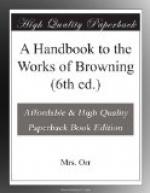St. John is dying in the desert, concealed in an inmost chamber of the rock. Four grown disciples and a boy are with him. He lies as if in sleep. But, as the end approaches, faint signs of consciousness appear about the mouth and eyes, and the patient and loving ministrations of those about him nurse the flickering vital spark into a flame.
St. John returns to life, feeling, as it were, the retreating soul forced back upon the ashes of his brain, and taxing the flesh to one supreme exertion. But he lives again in a far off time when “John” is dead, and there is no one left who saw. And he lives in a sense as of decrepit age, seeking a “foot-hold through a blank profound;” grasping at facts which snap beneath his touch; in strange lands, and among people yet unborn, who ask,
“Was John at all, and did he say he saw?” (vol vii. p. 128.)
and will believe nothing till the proof be proved.
This prophetic self-consciousness does not, however, displace the memory of his former self. John knows himself the man who heard and saw—receiving the words of Christ from His own mouth, and enduring those glories of apocalyptic vision which he marvels that he could bear, and live; seeing truths already plain grow of their own strength: and those he guessed as points expanding into stars. And the life-long faith regains its active power as the doubting future takes shape before him; as he sees its children
“... stand conversing, each new face
Either in fields, of yellow summer eves,
On islets yet unnamed amid the sea;
Or pace for shelter ’neath a portico
Out of the crowd in some enormous town
Where now the larks sing in a solitude:
Or muse upon blank heaps of stone and sand
Idly conjectured to be Ephesus:....”
(vol. vii. p. 134.)
and he hears them questioning truths of deeper import than those of his own life and work.
The subsequent monologue is an earnest endeavour to answer those questionings, which he sets forth, in order that he may do so; his eloquence being perhaps the more pathetic, that in the depth of his own conviction—in his loving desire to impart it—he assumes a great deal of what he tries to prove. “He has seen it all—the miracle of that life and death; the need, and yet the transiency, of death and sin; the constant presence of the Divine love; those things which not only were to him, but are. And he is called upon to prove it to those who cannot see: whose spirit is darkened by the veil of fleshly strength, while his own lies all but bare to the contact of the Heavenly light. He must needs be as an optic-glass, bringing those things before them, not in confusing nearness, but at the right historic distance from the eye.”




